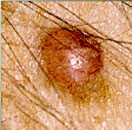- Skip Storing This Everyday Product in the Fridge Door
- Green Tea + B3 Pairing May Boost Brain Health
- Navigating Your Midlife Crisis: Embracing New Possibilities
- City Raccoons Showing Signs of Domestication
- Mapping the Exposome: Science Broadens Focus to Environmental Disease Triggers
- One Week Less on Social Media Linked to Better Mental Health
- Your Brain Changes in Stages as You Age, Study Finds
- Some Suicide Victims Show No Typical Warning Signs, Study Finds
- ByHeart Formula Faces Lawsuits After Babies Sickened With Botulism
- Switch to Vegan Diet Could Cut Your Greenhouse Gas Emissions in Half
Check Yourself for Signs of Skin Cancer, Doctors Advise


Many busy parents take the time to slather sunscreen on their children before heading outdoors, but they may neglect to protect their own skin. Dermatologists caution that skin cancer can affect anyone — even parents.
“As a mom, I understand how easily parents’ health can take a back seat to the needs of the family,” Dr. Doris Day said in an American Academy of Dermatology news release. Day is a clinical associate professor of dermatology at the NYU School of Medicine/Langone Medical Center in New York City.
“However, it’s important to value your own health and well-being as well as your children’s,” she said. “Take a few minutes even if it’s right after you shower or while you’re putting on your pajamas in the evening to check your skin regularly for the signs of skin cancer. It could save your life.”
Skin cancer is most treatable when it’s detected early. American Academy of Dermatology experts say everyone should learn the “ABCDEs” of melanoma, the most deadly form of skin cancer:
- A is for Asymmetry: One side of a mole is not identical to the other side.
- B is for Border irregularity: The mole has uneven, notched or blurred edges.
- C is for Color: The mole varies in color from one area to another.
- D is for Diameter: Most melanomas are bigger than the size of a pencil eraser when diagnosed, but can be smaller.
- E is for Evolving: A mole or skin lesion changes in size, shape or color over time.
Routinely checking the skin for these signs can help detect cancer early. Ask a family member to check hard-to-see places, like the back.
Dr. Ellen Marmur is an associate clinical professor of dermatology at the Icahn School of Medicine at Mount Sinai Medical Center in New York City. She said that one in five Americans will develop skin cancer in their lifetime, and one person dies of melanoma every hour.
“Check your skin regularly, and if you see anything that is changing, itching or bleeding, make an appointment right away to see a board-certified dermatologist,” she said in the news release.
More information
The American Cancer Society provides more information on skin cancer.
Source: HealthDay
Copyright © 2025 HealthDay. All rights reserved.










